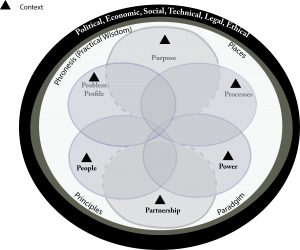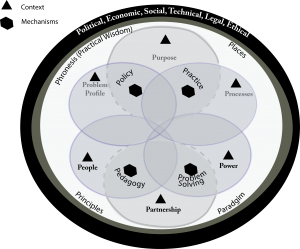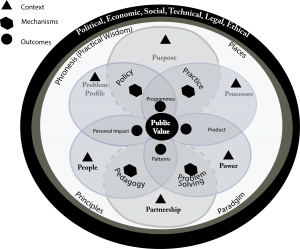
Developing Collective Leaders
The meaning of ‘leadership’ is a very slippery eel! Just as you think you understand it, along comes another interpretation that deserves attention. This has implications if we start to think about activities that are designed to develop our leaders and future leaders, as skill describes discrimination or knowledge in a specified matter. It thus concerns practical knowledge in combination with ability. Behaviour is the manner of conducting oneself in the external relations of life, represented by such characteristics as demeanour, deportment, bearing, or manners. Skills and behaviours support the collective values that leaders aspire to and the collective vision that these values underpin. The development of leaders must therefore take the collective vision and desired collective values as the starting point.
Language is often represented through frameworks and models, and the language of leadership is no different. This section briefly describes both a framework a model that can be used to structure, nurture, operationalise and assess public leaders’ development and application. Registered users will have the opportunity to explore this framework and model in more detail.
Aligning your Organisation’s Vision to Leadership Development
The development of skills and appropriate behaviours are key elements in transforming the collective vision into delivery and moving towards the stated aims of the vision. This requires organisations to align skills and behaviours within the context of a collective purpose and then provide the mechanisms to apply these consistently in practice, and then assess both leaders and leadership in achieving the collective outcomes. Values represent the ‘glue’ that binds these contexts, mechanisms and outcomes together.
The values of the organisation often reflect its’ culture and long term history whereas behaviours define the shorter (and more immediate) term climate. The organisational climate is a key driver of performance within a business or public service organisation. It is characterised by the atmosphere of working relationships within and without the organisation, and reflects how those who work within the organisation and, within its teams, feel about their working conditions and relationships.
A positive culture is of vital importance to the values in much the same way as demonstrated behaviours are to the prevailing climate. In a positive climate people are more likely to have a sense of clear purpose and what their role is within this purpose. Skills alone do not bring about leadership whereas behaviour can be a much stronger determinant of leadership. From a systemic view, knowledge management develops skills but behaviours are more inherent. Alignment of the two is thus critical. Collective leadership can thus provide both a framework and model in which a complex, but coordinated leadership development programme can be applied in the form of Applied Leadership Challenges.
A Collective Leadership Framework and Model
A framework is a way of representing the empirical relations between every aspect of inquiry when considering a theory or research. A model is something used to represent or explain the operation and mechanism of its practical impact. Within the framework and model, the alignment between leadership’s context, its mechanisms and the desired outcomes can be explored.
A conceptual model exists in one’s mind and can often consist of symbolic representations through symbols or diagrams. A model is useful because it relies less on words and language (which can be either ambiguous or socially constructed and thus, less reflective of the reality), and more on mechanisms and images. It assists in interpreting the phenomenon within its contextual setting (i.e. the framework) and can be more universally applied within different organisational and cultural settings and in helping to understand the underlying patterns of collective leadership.
From Principles to Public Value: The importance of Context
The word ‘context’ stems from the latin word ‘contextus’ which comprise the two words con (‘together’) and texere (‘to weave’). It describes the circumstances that form the setting for an event (i.e. leadership), and helps understanding. In this sense, context is not something that is directly controllable but one that does have a clear impact on intentions. The framework illustrated below – informed by both realistic evaluation and pragmatism – is based on detailed research into collective leadership over a number of years and shows the contexts for public leadership based on 20 P’s. This framework is broken down and described in much more detail within this web resource.
 The contextual analysis starts with the external environment (illustrated in the outer circle) comprising the political, economic, social, technical, legal and environmental conditions.
The contextual analysis starts with the external environment (illustrated in the outer circle) comprising the political, economic, social, technical, legal and environmental conditions.
The internal contexts are shown in the overlapping Venn-diagram style circles, beginning with Purpose (top), Partnership (bottom) and the interaction between Problem Profile and People (to the left) with, respectively, Processes and Power to the right.
The interaction between the internal and external contexts will be determined by what are described as the mitigating contexts, shown in the illustration as comprising the ‘leadership space’; the Principles (that help in defining the purpose based on the external contextual conditions), the Paradigm (the long-term culture or “the way-we-do-things-around-here” to the bottom of the space and the Places of leadership all drawn together by Aritotle’s conception of Phronesis, that is Practical Wisdom.
 How do we differentiate between Organisational Vision, Mission, Purpose, Goals and Objectives?
How do we differentiate between Organisational Vision, Mission, Purpose, Goals and Objectives?
These words trip off the tongue so easily in organisational life but are the words really meaningful? The terms are often confused and, in many cases, conflated. This is the role of the Mechanisms which are applied (or ‘triggered’) within the contextual model. Understanding the links between purpose and mission through to goals and objectives is critical to good planning (through Policy and Practice) when facing the significant challenges that are often presented to leaders. Focusing on the high level vision and core purpose will also be of benefit in aligning the contexts to practice and in applying problem solving approaches. Drawing these together through a pedagogy that focuses on applied leadership challenges sits at the heart of the suggested collective leadership development approach.
Outcomes that Create and Demonstrate Public Value
Mark Moore’s concept of Public Value (Moore, 1995) helps in defining the overall outcome of public leadership, which is the creation and demonstration of public value, which puts the public interest at the heart of public leadership. In drawing together the contexts and mechanisms the public value outcomes will be reflected by the identification of patterns (through intelligence – shown to the bottom of Pubic Value) and the implementation of programmes. A programme is a deliberate means of taking forward a course of action and each can be evaluated. Programmes can thus be viewed as a public statement of intent, with an itinerary, plan and schedule of what will be definitely undertaken. Finally, personal impact can assess individual leader’s roles within the wider leadership space whereas the product will be the result of the interventions or actions.
The ‘Selfless’ and ‘Intelligent’ Leader
In summary, the approach to developing collective leaders should reflect the real complexity of the leadership challenge, taking into account both external and internal contexts, applying the mechanisms that are likely to have the greatest impact on the collective vision and which is assessed in qualitative rather than quantitative terms, putting the public interest at the heart. This requires a different way of thinking about leadership and, in may ways, to encourage a new Paradigm (or the “the way-we-do-things-around-here”). The critical aspect of this leadership approach is to embrace that complexity but present it in a practical, intelligent and meaningful way. It is about values and behaviours and the real challenge is to shift a focus towards both selfless and intelligent leadership. We need to reverse the 4,000 year history of leadership that is ego-centric and individual to one that is about the collective public interest led by a collective leadership that is driven by collective values and a collective vision.
